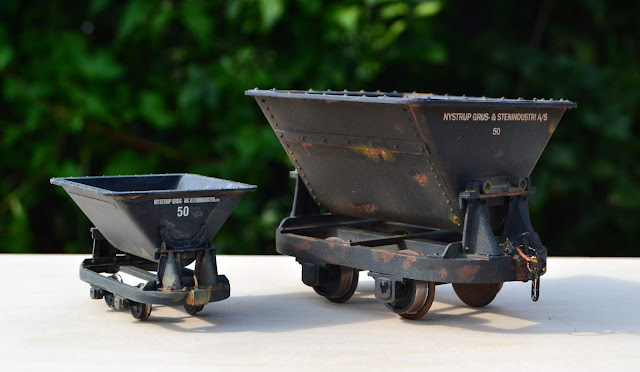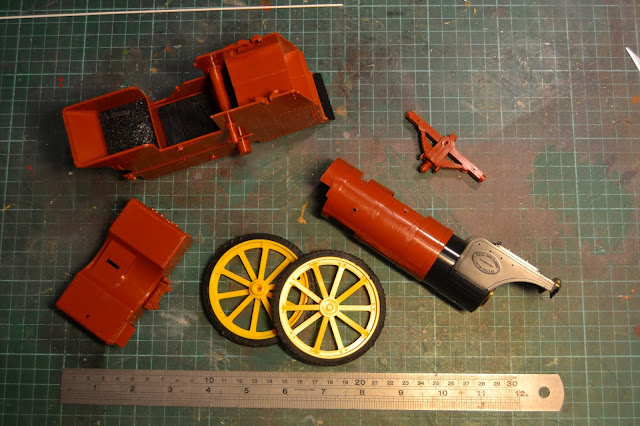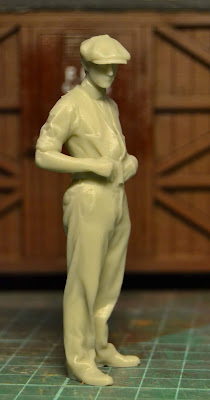Before long 2018 will have passed and a new year begins. 2018 was a year of radical change for Nystrup Gravel. Not even the little model railway's move in 2014 matches the change that hit the gravel company in 2018. Having modelled in 1:35 for more than 15 years I had a sense that something had to change to keep my motivation as high as usual. Before 2018 had come to an end, I had switched scale from 1:35 to 16 mm scale - also known as 1:19,05 on 32 mm gauge track.
 |
| An illustration of the change currently in progres on Nystrup Gravel. A massive increase in size. |
I began 2018 with finishing a 1:35 scale resin kit of a Soviet tractor with dozer blade. A great kit from Balaton Modell in Hungary. I fitted it with homemade decals for an imaginary East German brick works.
 |
| The Ernst Wollweber brick works tractor was my first finished model of 2018. It also turned out to be one of my last models in 1:35 scale. |
An extraordinary amount of my modelling took place outdoor in one of the sunniest and hottest summers ever recorded in Denmark. No end to hot afternoons after work and lovely evenings to spend under the parasol modelling and sipping cool wine.
 |
| Approaching the limit for modelling in the garden. Darkness brings an end to detail painting. The birds stop singing and the bats begin their hunt for insects. The mind wanders and new projects are considered. |
Some of the summer evenings were spent building a
living van and a water cart for my steam roller. Both wagons were largely built from left over parts and plasticcard. Many years of modelling has enabled me to build up a large collection of parts (some of them in different scales) that can come in useful. That made the two wagons my cheapest projects of the year.
 |
| A steam roller road train on my road photo plank photographed in my garden in the warm Danish summer. |
A trip to Wales made a profound difference for my modelling. In the shop at Tywyn on the Talyllyn Railway I picked up a 16 mm scale plastic kit. Under usual circumstances I would never have looked at or handled a kit in any other scale than 1:35 or 1:32. But as I had recently been lacking motivation in my modelling, my usual focus was probably disturbed. Holding the GVR granite wagon kit from Binnie Engineering in my hand I remembered the articles in Narrow Gauge and Industrial Railway Modelling Review about 16 mm scale and the kit was placed on top of my heap of books on the counter.
 |
| My double identity GVT wagon. It's numbered 130 on one side and 157 on the other. |
I started the 16 mm kit while on summer vacation and had great fun with the assembly. The large size appealed a lot to me and it even
allowed me to work on the kit with a bandaged broken left wrist. I ordered af few more kits to get a better feel of the scale and checked the availability of road vehicles and figures. It turned out that what I needed for a small layout was available and I started to wonder if a change of scale would be the right thing.
After much head scratching and consideration I decided it was time for radical change and as a consequence I now model in 1:19.05 scale. A selection of my 1:35 scale models have since found a new home on fellow European modellers' layouts. I will offer more models for sale before too long.
 |
| Loco 78 and a few skips in company with a 1:35 scale figure named 'Claus' on a German layout. I hope they will contribute to the develpoment of the local industry in the future. Photo: L. Behme. |
It's a big task beginning from scratch and building up a new model railway. 2019 will be used to build up a larger collection of rolling stock and finishing my first 16 mm scale locomotive as well as buying my first length of track. I hope to start traffic as soon as posible as demand for gravel continue to be high.
 |
| Two models I'm currently working on: the Bandai steam traction engine and the I P Engineering Lister.More about them in 2019. |
My best greetings to all you readers and contributors to the blog. Thanks for your input and ideas, regardless if made here, on Facebook or an online forum. All the best wishes for health, modelling and life in general. Happy New Year!




















































